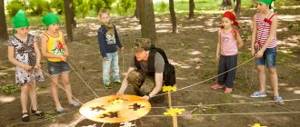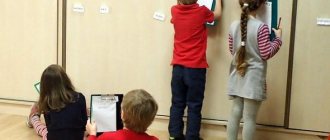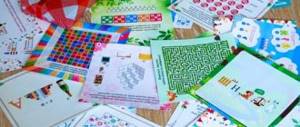At the present stage of development of the educational system in Russia, new technologies and activity-based forms of interaction between participants in the educational process appear. The most popular are interactive forms that allow the involvement of all participants in the educational process and the realization of their creative abilities, the implementation of existing knowledge and skills in practical activities. Such forms of organizing educational activities include: an interactive game, a master class, project activities, creating problem situations, experimentation, etc. All these forms can exist as separate elements, or can be combined with each other and varied by the teacher when planning a particular type educational activity or joint event with parents and children. They combine especially well in quest technology, or as it is also called an educational quest, which is most often popular among teenagers and adults due to the extraordinary organization of educational activities and an exciting plot.
Quest technology in the educational and general educational process as a concept appeared relatively recently. The computer games of the quest genre that appeared a couple of decades ago played a big role in this.
Let's consider the main aspects related to understanding this process:
- what are quest technologies in education;
- basic principles of quest development;
- simple examples of using quests.
Quest - “search, subject of search, search for adventure.” In mythology and literature, the concept of “quest” originally meant one of the ways to construct a plot - the journey of characters to a specific goal through overcoming difficulties.
The very concept of “quest” will actually mean a game, a search that requires players to solve certain mental problems in order to overcome obstacles and move through a plot that can be defined or have many outcomes, where the choice will depend on the actions of the player himself.
An educational quest is a pedagogical technology that includes a set of problem-based tasks with role-playing game elements. They can cover a separate problem, academic subject, topic, and can also be interdisciplinary. Quests can be used to work with students, parents, and colleagues.
A little history
Quest technologies in education and upbringing of children began to be widely used in 1995, when Bernie Dodge, a professor at the University of San Diego, proposed using a certain search system in the learning process, in which it was supposed to find a solution to a given problem with the passage of intermediate stages, at each of which it was necessary to complete some action or find the key to reach the next level. Initially, the web quest technology of that time was not even about finding a logical solution, but rather was intended to interest the child by creating a process similar to a game. It was games (in any of their manifestations) that became the starting point that served as the development of this direction in pedagogy. With the evolution of computer technology, such processes have become interactive, which has made it possible to attract an even larger audience of children to them, because modern teenagers often spend much more time playing computer games than doing homework and mastering educational material presented at school. (Read more on FB.ru: https://fb.ru/article/248308/kvest-tehnologiya-v-obrazovanii-i-vospitanii-rol-kvest-tehnologiy)
The term “quest” as an educational technology was first proposed by Bernie Dodge. The scientist developed innovative Internet applications for integration into the educational process when teaching various academic subjects at different levels of education. He called a quest a site that contains a problem task and involves an independent search for information on the Internet.
Attempts to expand and supplement Bernie Dodge's definition were made by Thomas March (University of San Diego), who significantly detailed the concept and presented a number of theoretical formulations that help to gain a deeper understanding of the essence of quest technology.
A quest (or web quest), according to T. March, is a scaffold-type educational structure that uses links to essential resources on the Internet and an authentic task in order to motivate students to study a problem with an ambiguous solution , thereby developing their ability to work both individually and in a group (at the final stage) in searching for information and transforming it into more complex knowledge (understanding). The best quests achieve this in such a way that students begin to understand the richness of thematic connections, become more easily involved in the learning process, and learn to reflect on their own cognitive process.
Largely based on the works of L.S. Vygotsky, especially his doctrine of the “zone of proximal development”, T. March argued that this type of search activity needs “supports” that the teacher must provide. Scaffolds are about helping students work outside their actual skill area. Examples of supports can be activities that help students correctly construct a research plan, involve them in solving a problem, and direct attention to the most essential aspects of the study.
Teachers all over the world have begun to use this technology as one of the ways to successfully use the Internet in the classroom. In our country, this technology is just beginning to spread.
Quests are divided into two groups based on location: “live” quests in reality and web quests using Internet resources.
Depending on the type of game, quests can be varied: adventure quests, project quests, puzzle quests, etc.
Quest technology structure:
- statement of the problem (introduction) and distribution of roles;
- list of tasks (stages of completion, list of questions, etc.);
- the procedure for completing the task (fines, bonuses);
- the final goal (prize).
With the participation of children in quests, the following goals are achieved:
- educational – involving each student in an active cognitive process. Organization of individual and group activities of schoolchildren, identification of skills and abilities to work independently on the topic.
- developmental – development of interest in the subject, creative abilities of the imagination of students; developing skills in research activities, public speaking, skills of independent work with literature and Internet resources; broadening one's horizons and erudition.
- educational – instilling tolerance, personal responsibility for performing the chosen work.
Teachers of educational institutions are increasingly paying attention to the quest as an innovative pedagogical technology and learning model.
Computer games
This is the name of a popular gaming genre that has gained a huge army of fans. There are games that are entirely built on the principle of a quest, and there are those that only include its elements.
In the quest, the player, searching for objects and solving logical problems, consistently moves through the plot, interacting with other characters.
There are no battles or other elements that require rapid response, or they are kept to a minimum. Until the current task is completed, you will not be able to move on.
Another name for computer quests is “adventure games”.
The first computer quests were text-based. The oldest of them is Colossal Cave Adventure, in which the character searches for treasure in a cave. The first version was invented in 1975 by programmer and speleologist William Crowther. With the development of technology, text-based “adventures” were supplanted by graphic ones, and sound recording of what was happening appeared.
Among the most famous games in this genre are Deponia (a series about the adventures of Rufus on the landfill planet Deponia), Syberia (3 series about the adventures of a girl lawyer Kate Walker), The Walking Dead: The Game (a story about a zombie apocalypse).
Web-quest technology as a new learning model
Modernization of education, based on new information technologies, involves the formation of new models of educational activities using information and telecommunication teaching aids.
Currently, the problem of maintaining and developing the educational motivation of schoolchildren is now the most pressing. Nowadays, it is difficult for teachers to find the right approach to children, because “nothing will surprise them,” and it is difficult to interest and motivate them. This problem is solved to some extent by the use of “web quest” technology, which takes into account the active use of computer technologies by schoolchildren in everyday life.
“Web quest” is a special type of search activity that students could carry out using the Internet.
The word Web (from English) is a web, a network.
The word Quest (from English) means research, search.
Therefore, WebQuest can be translated from English as web searches on the network.
Thus, a web quest is a site on the Internet that will contain information on a specific topic or section of an academic subject, with some or all of the information located in the form of hyperlinks to the web pages on which it is located.
Since the term “web quest” arose relatively recently, a variety of interpretations of the web quest can be found in the literature of domestic teachers. For example:
A webquest is a scenario for organizing student project activities on any topic using Internet resources.
A webquest is an Internet site that students work with to complete one or another educational task. Such web quests are being developed to maximize the integration of the Internet into various educational subjects at different levels of study in the educational process.
In the works of domestic scientists there is no single view on the essence of the quest; being a relatively new technology in pedagogy, the quest has not yet passed the stage of theoretical justification. This work is just underway. The problem of quests in our country is dealt with by Andreeva M.V., Bykhovsky Ya.S., Nikolaeva N.V. and others.
Webquest, as an educational technology, is based on a constructivist approach to learning. According to this approach, the teacher plays the role of consultant, organizer and coordinator of problem-oriented, research, educational and cognitive activities of students. He creates conditions for independent mental activity of students and supports their initiative in every possible way. In turn, students become full “participants” in the learning process, sharing responsibility for the learning process and results with the teacher. The advent of the Internet and its widespread use have forced educators to look for ways to effectively use this technology.
According to the criteria for assessing the quality of a webquest developed by T. March, a good educational quest should have an intriguing introduction, a clearly formulated task that provokes higher-order thinking, a distribution of roles that provides different angles on the problem, and a reasonable use of Internet sources.
A webquest, using Internet information resources and integrating them into the educational process, helps to effectively solve a number of practical problems, since in the process of working on a webquest a number of competencies are developed:
- use of information technologies to solve professional problems;
- self-learning and self-organization;
- skill to work in team;
- the ability to find several ways to solve a problem situation.
Bernie Dodge identified the following types of tasks for webquests:
- retelling - demonstrating an understanding of a topic based on presenting materials from different sources in a new format: creating a presentation, poster, story;
- planning and design - developing a plan or project based on given conditions;
- self-knowledge - any aspects of personality research;
- compilation - transformation of the format of information obtained from various sources: creating a book of culinary recipes, a virtual exhibition, a time capsule, a cultural capsule;
- creative task - creative work in a certain genre - creating a play, poem, song, video;
- analytical task - searching and systematizing information;
- detective, puzzle, mysterious story - conclusions based on contradictory facts;
- achieving consensus - developing a solution to a pressing problem;
- assessment - justification of a certain point of view;
- journalistic investigation - objective presentation of information (separation of opinions and facts);
- persuasion - winning over opponents or neutral-minded people to your side;
- scientific research - the study of various phenomena, discoveries, facts based on unique online sources.
Webquest structure.
The webquest includes the following parts as mandatory:
- introduction (topic and rationale for the value of the project). This stage provides background information, introduces key concepts, and contains a question for students to reflect on;
- task (goal, conditions, problem and ways to solve it). This is the most important part of the webquest. The task directs students to a series of specific actions towards solving a problem;
- process (step-by-step description of the progress of work, distribution of roles, responsibilities of each participant, links to Internet resources, final product). This section contains instructions on how students will complete the task (order of completion and sorting of information);
- assessment (self-assessment scale and teacher assessment criteria). The section contains criteria for assessing the completed task in accordance with certain standards;
- conclusion (summarizing the results, summing up (what was learned, what skills were acquired; rhetorical questions or questions motivating further research on the topic are possible). Here the results are summed up and reflection and further research on the problem are encouraged;
- Teacher pages (optional): These contain information to help other teachers who will be using the webquest.
The stages of working on a webquest include:
Initial stage (team)
Students become familiar with the basic concepts of the chosen topic and materials from similar projects. Roles in the team are distributed: 1-4 people per role. All team members should help each other and teach each other how to use computer programs.
Role stage
Individual work in a team for a common result. Participants simultaneously complete tasks in accordance with their chosen roles. Since the goal of the work is not competitive, in the process of working on the web quest, team members mutually learn skills in working with computer programs and the Internet. The team jointly sums up the results of each task, the participants exchange materials to achieve a common goal - creating a website.
Tasks of this stage:
- searching for information on a specific topic;
- development of the site structure;
- creating materials for the site;
- finalization of materials for the site.
The final stage
The team works together, under the guidance of a teacher, and feels responsible for the research results published on the Internet.
Based on the results of the study of the problem, conclusions and proposals are formulated. A competition of completed works is held, where the understanding of the task, the reliability of the information used, its relationship to a given topic, critical analysis, logic, structure of information, definiteness of positions, approaches to solving the problem, individuality, and professionalism of presentation are assessed. Both teachers and students take part in evaluating the results through discussion or interactive voting.
The actual placement of webquests on the Internet can significantly increase student motivation to achieve the best educational results.
The key section of any webquest is a detailed scale of evaluation criteria, based on which project participants evaluate themselves and their teammates. The teacher uses the same criteria.
A webquest is a complex task, so the assessment of its completion should be based on several criteria focused on the type of problem task and the form of presentation of the result. Bernie Dodge recommends using 4 to 8 criteria, which may include assessment:
- research and creative work,
- quality of argumentation, originality of work,
- skills of working in a small group,
- oral presentation,
- multimedia presentation,
- written text, etc.
Types and forms of webquests.
There are several classifications of web quests. Bernie Dodge identifies three principles for classifying webquests:
- By duration of implementation: short-term and long-term.
- By subject content: mono-projects and interdisciplinary web quests.
- By type of tasks performed by students.
The goal of short-term projects is to acquire knowledge and integrate it into your knowledge system. Working on a short-term web-quest can take from one to three sessions. Long-term web-quests are aimed at expanding and clarifying concepts. Upon completion of work on a long-term web-quest, the student must be able to conduct a deep analysis of the knowledge gained, be able to transform it, and master the material enough to be able to create tasks for work on the topic. Work on a long-term web-quest can last from one week to a month (maximum two).
Today, there are twelve types of webquests, the classification of which is based on the 12 types of tasks defined by Bernie Dodge (see above).
For example:
- Compilation tasks - data collection task.
This is the simplest webquest, since the students’ goal is the following: to view certain Internet resources and select the information necessary for any compilation (cookbook, herbarium, etc.).
- Judgient tasks - an opinion task.
The purpose of this webquest is to collect data about a specific event for the further presentation of your opinion about it.
- Retelling tasks - task for retelling.
The task is aimed at searching for information for the purpose of its further retelling. For example, when completing a webquest about the British Isles, a student collects and summarizes information about an English-speaking country in order to produce a final product, for example, a multimedia presentation of this country. When completing a webquest in a group, responsibilities can be divided: a geographer must collect information about the geographical location of the country, a historian must study all significant historical events for a certain period, and a sociologist must prepare a study of tourist attractions to create a virtual tour of the country.
More details on the types of webquests can be found in the article Van Loo E., Bron J.T., Jansen Y. Experiments in task-based learning of the Russian language: “language fair” and “web quest in the Russian language” and regional studies" // Russian word in world culture. Materials of the Xth Congress of MAPRYAL. Round tables: Collection of reports and messages. St. Petersburg, 2003.
Web quest forms can also be different. Here are the most popular:
- Creation of a database on the problem, all sections of which are prepared by students.
- Creating a microworld in which students can navigate using hyperlinks, simulating physical space.
- Writing an interactive story (students can choose options for continuing work; for this, two or three possible directions are indicated each time; this technique is reminiscent of the famous choice of a road at a road stone by Russian heroes from epics).
It should be noted that different types of webquests can combine similar elements and tasks, therefore, there are no clear boundaries between their types.
The topics of webquests can be very diverse; problem tasks can vary in degree of complexity. The results of completing a webquest, depending on the material being studied, can be presented in the form of an oral presentation, a computer presentation, an essay, a web page, etc.
"Live" quests in education
The ancestors of real “live” quests are computer games in which players had to solve puzzles and overcome obstacles in order for their computer hero to reach the end of the game. Only all these tasks were performed in the virtual world. Unlike computer quests, quests in “reality” are still developing.
The first attempt to transfer a virtual computer quest into reality was made in Asian countries in 2007, after which it began to be implemented in Europe, and then in Russia (2013). As you can see, this is a fairly new, young innovation, but despite this, it is confidently gaining momentum and becoming a popular and sought-after trend.
Although, in a methodological sense, quests are not something completely new. Surely everyone played the military-patriotic game “Zarnitsa” during their school years, which, in essence, is a quest.
In the educational process, a quest is a specially organized type of research activity, where students search for information at specified addresses (in reality), including a search for these addresses or other objects, people, tasks, etc.
Unlike an educational problem, an educational quest has elements of a plot, a role-playing game related to the search and discovery of places, objects, people, information, and resources of a certain territory or information resources are used to solve educational problems.
A “live” quest not only allows each participant to demonstrate their knowledge and abilities, but also contributes to the development of communication interactions between players, which stimulates communication and serves as a good way to unite the players. In such quests there is usually an element of competition, as well as the effect of surprise (unexpected meeting, mystery, atmosphere, scenery). They contribute to the development of analytical abilities, develop imagination and creativity. The use of quests allows you to move away from traditional forms of teaching children and significantly expand the scope of the educational space.
Quest is a fun adventure game for both children and adults in which participants must solve certain problems to advance through the plot and achieve a specific goal.
Tasks can be very different in content and content: active, creative, intellectual, etc. It is especially significant that quests can take place both in an enclosed space (classroom, school premises) and outdoors, in nature (territory, city, park, etc.), covering the entire surrounding space. Among them, geocaching is especially interesting - a quest in an open area with a search for treasure, a hiding place and with elements of terrain orientation.
Quest structure:
Stages of organizing the quest:
When planning and preparing a “live” quest, it is important to think through the plot and the educational space where the game will take place, how many participants and organizers there will be, where the participants will start from, will move in a certain sequence or choose their own route. Depending on this, real quests can be divided into three groups:
To create a route, you can use different options:
- route sheet (the stations can simply be written on it sequentially and where they are located; or there can be riddles, rebuses, an encrypted word, the answer to which will be the place where you need to go);
- map (schematic representation of the route);
- “Magic screen” (tablet or laptop, collage with sequential photographs of the places where participants should go);
- participants can learn where to go next after completing a task at a station (from the organizer; the answer to the task is the name of the next station; you need to find a hidden clue in a certain area), etc.
Most often we use linear quests in our work, where participants go from one point along a certain route and meet at another point, at the final station.
Principles of organizing quests.
In order to effectively organize children's quests, you should adhere to certain principles and conditions:
- all games and tasks must be safe;
- the tasks assigned to children must correspond to the age of the participants and their individual characteristics;
- different types of activities need to be introduced into the content of the scenario;
- tasks must be thought out in such a way that they are consistent and logically interconnected;
- if possible, the game should be emotionally charged with the help of scenery, music, costumes, and equipment;
- children must clearly understand the goal of the game they are striving for;
- you should consider time intervals during which children will be able to complete the task, but will not lose interest in it;
- The role of the teacher in the game is to guide the children, “push” them to the right decision, but the children must make the final conclusions on their own.
The main criteria for the quality of a quest are its safety for participants, originality, logic, integrity, subordination to a specific plot, and not just a theme, and the creation of an atmosphere of a gaming space.
Quest: origin and essence of the concept
“Quest” in English means “search”, “object being sought”. The consonant verb “to quest” is translated as “ to seek ”, “to search for”.
In simple words, a quest is a movement towards a specific goal associated with overcoming difficulties and searching for something.
You can visualize this by remembering the TV show “ Fort Boyard ”. Also, folklore is full of elements of the quest (12 labors of Hercules, the tale of Koshchei, whose death is in a needle, a needle in an egg, an egg in a duck, and the list goes on).
Perhaps the most interesting search fell to the fairy-tale shooter Andrei: “Go there, I don’t know where, bring that, I don’t know what.” A technique that depicts the path of the main character to a goal is common in fantasy.
Gradually, this concept migrated to other areas, changing its original meaning. There is a novel with the same name (author – Boris Akunin), an action series “Quest” with a dashingly twisted plot was filmed. But most often it is used in the gaming industry .
Bibliography:
- Vasilenko A.V. Quest as a pedagogical technology. The history of quest technology. International electronic pedagogical journal "Predmetnik". [Electronic resource] – access mode: https://www.predmetnik.ru/conference_notes/69
- Bykhovsky Ya. S. Educational web quests // Proceedings of the international conference “Information technologies in education. ITO-99".
- Analysis of the “web-quest” technology as a new pedagogical model of teaching. [Electronic resource] – access mode: https://knowledge.allbest.ru/pedagogics/2c0b65635b2ac79a4d53a88521306d27_0.html
- Polat E.S., Bukharkina M.Yu., Moiseeva M.V., Petrov A.E. New pedagogical and information technologies in the education system / Proc. aid for students ped. universities and higher education systems qualified ped. personnel / ed. E. S. Polat - M.: Publishing House, 2001.
- Dmitrieva E.V. Quest - as one of the activity forms of organizing the educational process of a preschool educational institution within the framework of the implementation of the Federal State Educational Standard for Preschool Education. https://imc-peterhof.spb.ru/stati/materialy/kvest-kak-odna-iz-deyatelnostnykh-form-organizatsii-obrazovatelnogo-protsessa
- Kudaeva N.B. Training course: Educational technology web quest.
- Kolesnik M.A. Educational quest: Master class for teachers. hhttps://www.menobr.ru/article/60157-qqe-16-m9-obrazovatelnyy-kvest-master-klass-dlya-pedagogov








